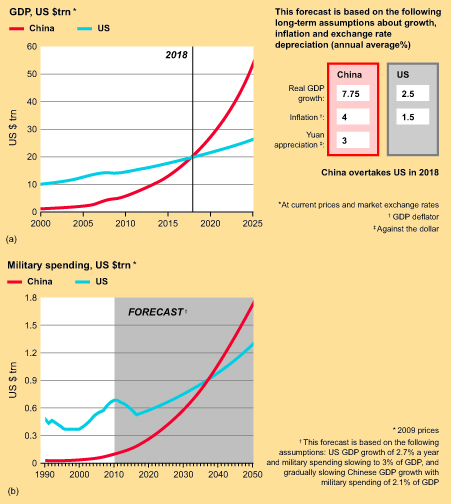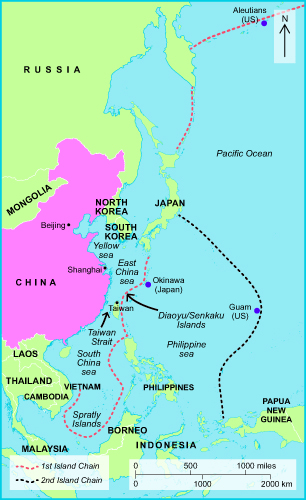2 China and the United States in the twenty-first century
At the start of the twenty-first century China is seen by some analysts as poised to become the world’s next superpower, joining, or perhaps even usurping the United States at the apex of global power. Estimates vary, but most see China’s economy overtaking the United States in terms of its overall size at some point. It is ‘at the centre of a tectonic shift in the balance of economic power in the international economy’ (Bromley, 2009, p. 149). Defence spending in China has been rising rapidly since 1990 and on some estimates will equal that of the United States by around 2035 (The Economist, 2012). China has already overtaken the United States as the largest emitter of greenhouse gases. Such changes, coupled with the impact on Western economies of the economic crisis of 2008 and the rise of other large developing countries like India and Brazil, signal a potential historic turning point in world history. Indeed, by 2060 the economies of the developing world are predicted to outweigh the economies of the developed world for the first time since the industrial revolution (OECD, 2012). While such projections are inherently fallible, as actual growth rates are often significantly different from those forecast, for some commentators, the political implications of these changes will be profound – a future in which international politics will no longer be dominated by the United States and the West.
In economic matters, China and the United States have developed dense and extensive linkages. Total trade in goods and services between China and the United States (US imports from China plus US exports to China) amounted to over US$550 billion in 2011 (US Census Bureau, 2013) with China being the United States’ largest supplier of imports and its third largest export market. For many years, China has been a major creditor for the United States, holding substantial US debt. While some take such linkages as signs of burgeoning cooperation, others focus on the conflicts such relationships generate: the United States fears its trade deficit with China is a source of weakness; China fears potential US protectionism.


In foreign policy matters, issues around human rights and the treatment of religious and ethnic minorities, as well as the disputed positions of Taiwan and Tibet, have been flashpoints in China–United States relations. China’s criticism of US foreign policy in the Middle East and elsewhere and disagreements on the UN Security Council in which both are permanent, veto-carrying members, have created tensions at times. China’s fraught relationship with some of the United States’ closest allies in South and East Asia – Japan and South Korea among them – also raises military and security issues that are not easily handled. While both share common interests in stability in the region, China’s increasing military expenditure and US support for Taiwan (which China claims as part of its own territory), create much space for suspicion and distrust. China’s claims to territory held by Japan and Vietnam (the Diaoyu/Senkaku and Spratly Islands, respectively) and rights in the South China Seas, are also potential flashpoints. In both China and the United States, analysts are grappling with questions about the extent to which the future relationship will be founded on cooperation or conflict.
